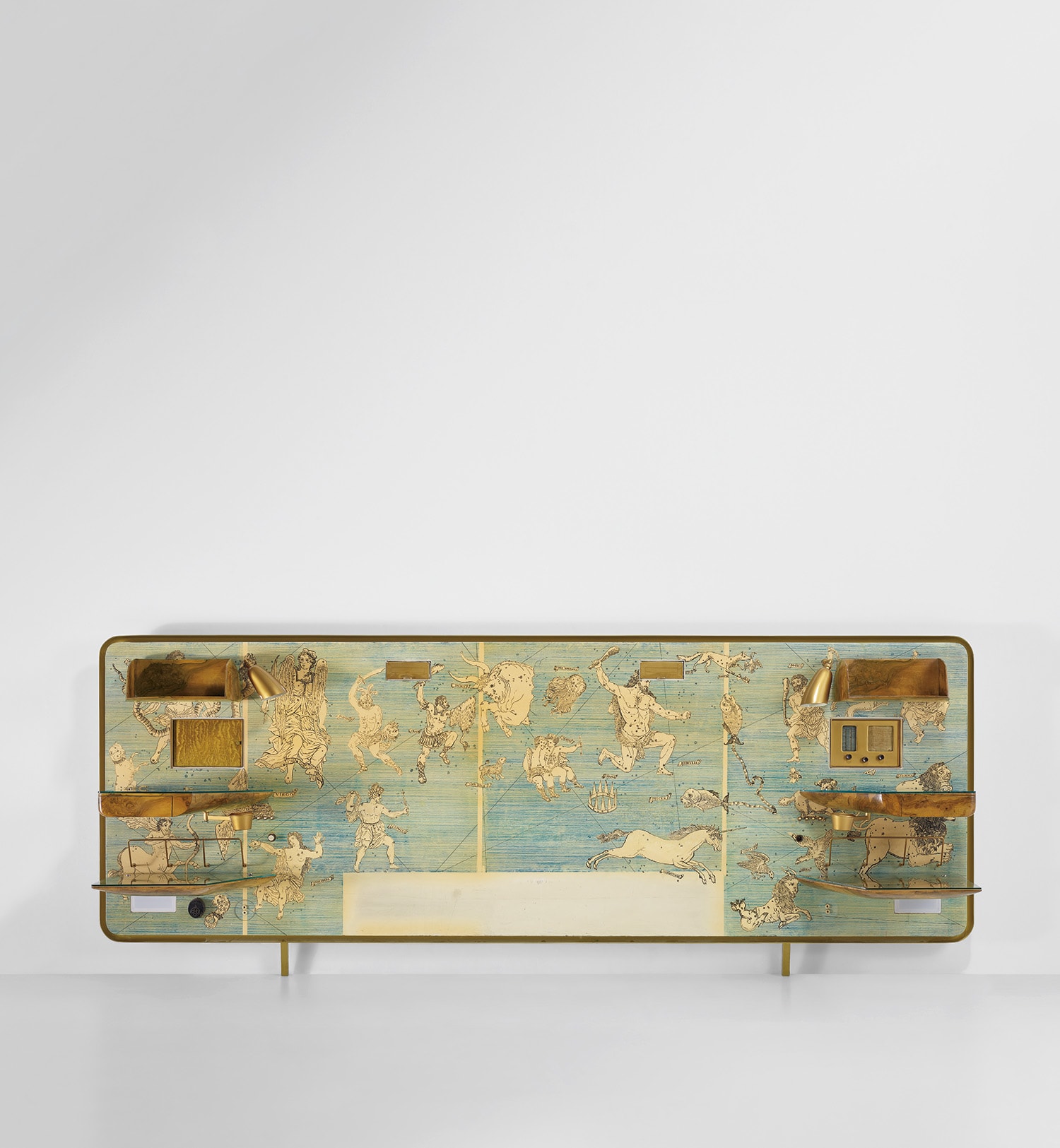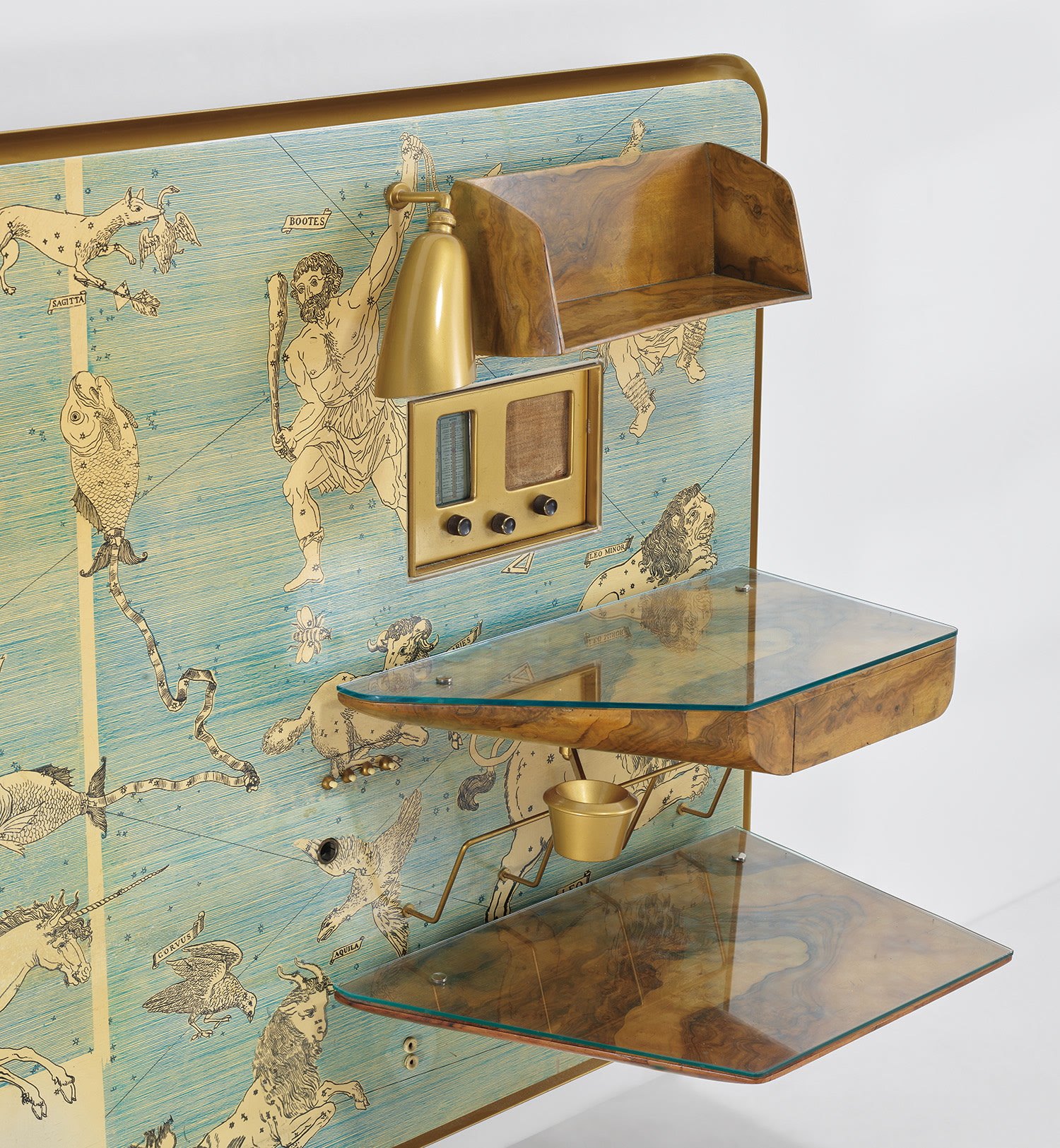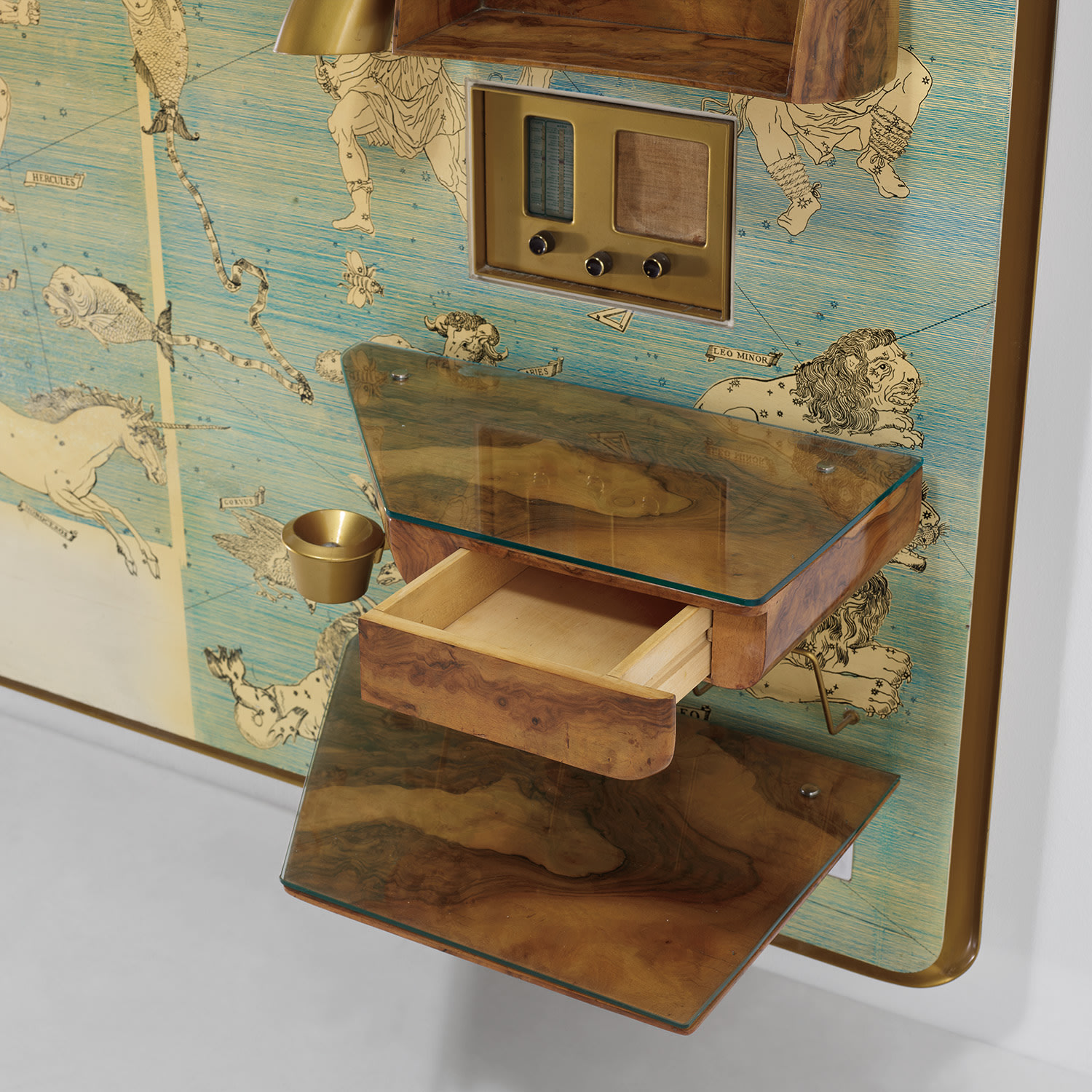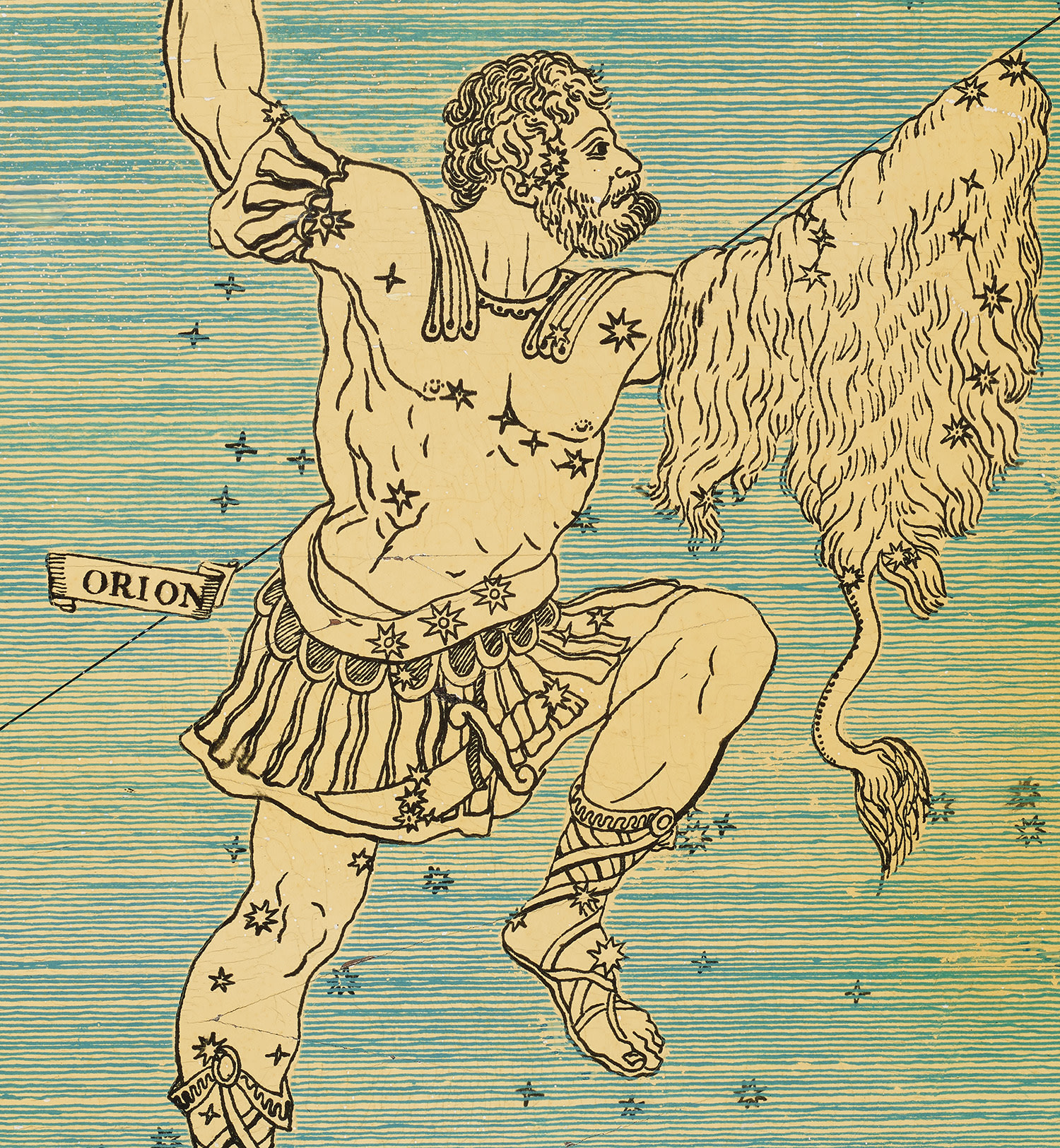









2
Gio Ponti and Piero Fornasetti
Unique illuminated headboard
circa 1952
Lithographic transfer-printed wood, painted wood, painted brass, painted steel, burr walnut-veneered wood, glass, brass, fabric, acrylic.
120.5 x 309 x 53.6 cm (47 1/2 x 121 5/8 x 21 1/8 in.)
Executed by Giordano Chiesa, Milan, Italy. Glass tabletops acid-etched PROTEX. Together with a certificate of expertise from the Gio Ponti Archives.
Full-Cataloguing
The Constellation within Casa di Fantasia
In the early 1950s, Gio Ponti designed the interior of Casa Lucano, a large Milanese apartment that the architect described as a ‘Casa di Fantasia’ (offered by Phillips, 21 March 2019). Through his extraordinary vision, Ponti transformed the residence into a ‘fantasy house’ in which entire walls were covered in burr walnut-veneered and lithographic transfer-printed wood panels. The use of burr walnut and the trompe l’œil imagery of the lithographic transfer-printed walls extended across the apartment’s doors, built-in cabinets, furniture and textiles. Ponti incorporated interior windows and niches—illuminating anthropomorphic ceramic statuettes—through the enfilade of four rooms (living room, study, dressing room, bedroom), creating a series of actual and illusionary vistas. Ponti designed the stage set-like interior to be versatile in order to allow his clients to animate and determine its function, an idea that was central to Ponti’s post-war designs. The walls with external windows were fitted with printed floor-length curtains that could be pulled across the entire wall to fully enclose the interior space, evoking the dream-like compositions of Italian Metaphysical and French Surrealist painting.
To create the apartment’s extensively decorated surfaces, Ponti entrusted collaborators including the artists Piero Fornasetti, Edina Altara and Fausto Melotti. This artistic dialogue, as well as that with his clients, was essential in the realisation of the apartment’s inventive narrative. Altara depicted mythological subjects on doors and on two chest of drawers with verre églomisé fronts, while Melotti created vibrant enamelled tiles and fixtures for the apartment’s utilitarian rooms. Sofas and chairs were enlivened with Fornasetti’s depictions of stacked books, scattered papers, and assortments of fish, fruit, flowers and butterflies. In the living room, his hot air balloon patterned curtains formed an expansive backdrop for the display of Fulvio Bianconi's Venini glass objects, while the study’s walls featured a vast printed collection of books, documents, classical-inspired objects and framed portraits. Throughout the interior, the visual effects of Fornasetti’s lithographic transfer-printed wall panels, furniture and printed textiles created a sense of lightness and apparent dematerialisation of the volumes within the space.
The apartment was featured in a 1952 issue of Domus, in which Ponti described how ‘everything appears to be a bit magical, without weight or volume, because a print eliminates the volume’. By the time of Casa Lucano’s completion in the early 1950s, Ponti and Fornasetti had already been collaborating together for over a decade. Ponti had discovered the work of Fornasetti at the Fifth Milan Triennale in 1933 and the architect and painter first worked together in 1940, designing furniture for the Italian glass company Fontana Arte. They went onto create vibrant interiors for residences, offices, shops, and ocean liners and collaborated on the 1950 landmark exhibition ‘Italy at Work: Her Renaissance in Design Today’, which travelled to twelve museums across the United States. In his 1952 article, Ponti wrote, 'If it was worthwhile to chronicle my life as an architect, a chapter beginning in 1950 could be titled ‘Passion for Fornasetti’. What does Fornasetti bring to this interior? With his ingenious printing process, the possibility of having ‘unique’ objects… an effect of lightness and evocative magic’ (Domus, no. 270).
For the bedroom of Casa Lucano, Ponti designed the present headboard featuring illustrations of the zodiac constellations by Fornasetti. The headboard’s burr walnut-veneered shelving and side tables appear suspended within Fornasetti’s celestial vault, creating the sense of lightness and magic described by Ponti, and belying the object’s large dimensions and mass. The classical motif was repeated in the expansive curtains, which extended across the curved wall directly opposite the bed, from which the city dweller could gaze out into the constellations. Both Ponti and Fornasetti revered Italy’s cultural heritage, in particular the visual language of the Renaissance and classical art and architecture, which in the present work was applied to blur the distinction between the bedroom’s furniture and walls.
The design of the headboard relates to Ponti’s concept of the parete attrezzata (organised wall). Having first combined shelving, light fixtures and objects within a single panel in the late 1940s, the idea continued to inform Ponti’s interior design of domestic and commercial spaces with an increasing focus on visual lightness. Writing in Domus, Ponti explained, 'instead of shelving and bookcases, the so-called 'four-feet furniture', I am moving more and more…towards the pareti organizzate, large panels adhering and hanging on the walls (and maybe with a support) in which the disposition of the various objects follows a pre-arranged composition' (Domus, no. 266). From the parete attrezzata, Ponti developed his idea for a headboard-panel that contained all the required necessities. Set within Fornasetti’s composition, Ponti incorporated burr walnut side tables, shelving and magazine racks with brass lighting, a built-in radio, cigarette lighters, cigar holder and ashtrays in the present headboard. The brass shell supports the lithographic transfer-printed panel that allowed for the installation of all the electrical components. Through Ponti and Fornasetti’s imaginative spatial and pictorial inventions, the present headboard became a microcosm within the created universe of the ‘casa di fantasia’.
In the early 1950s, Gio Ponti designed the interior of Casa Lucano, a large Milanese apartment that the architect described as a ‘Casa di Fantasia’ (offered by Phillips, 21 March 2019). Through his extraordinary vision, Ponti transformed the residence into a ‘fantasy house’ in which entire walls were covered in burr walnut-veneered and lithographic transfer-printed wood panels. The use of burr walnut and the trompe l’œil imagery of the lithographic transfer-printed walls extended across the apartment’s doors, built-in cabinets, furniture and textiles. Ponti incorporated interior windows and niches—illuminating anthropomorphic ceramic statuettes—through the enfilade of four rooms (living room, study, dressing room, bedroom), creating a series of actual and illusionary vistas. Ponti designed the stage set-like interior to be versatile in order to allow his clients to animate and determine its function, an idea that was central to Ponti’s post-war designs. The walls with external windows were fitted with printed floor-length curtains that could be pulled across the entire wall to fully enclose the interior space, evoking the dream-like compositions of Italian Metaphysical and French Surrealist painting.
To create the apartment’s extensively decorated surfaces, Ponti entrusted collaborators including the artists Piero Fornasetti, Edina Altara and Fausto Melotti. This artistic dialogue, as well as that with his clients, was essential in the realisation of the apartment’s inventive narrative. Altara depicted mythological subjects on doors and on two chest of drawers with verre églomisé fronts, while Melotti created vibrant enamelled tiles and fixtures for the apartment’s utilitarian rooms. Sofas and chairs were enlivened with Fornasetti’s depictions of stacked books, scattered papers, and assortments of fish, fruit, flowers and butterflies. In the living room, his hot air balloon patterned curtains formed an expansive backdrop for the display of Fulvio Bianconi's Venini glass objects, while the study’s walls featured a vast printed collection of books, documents, classical-inspired objects and framed portraits. Throughout the interior, the visual effects of Fornasetti’s lithographic transfer-printed wall panels, furniture and printed textiles created a sense of lightness and apparent dematerialisation of the volumes within the space.
The apartment was featured in a 1952 issue of Domus, in which Ponti described how ‘everything appears to be a bit magical, without weight or volume, because a print eliminates the volume’. By the time of Casa Lucano’s completion in the early 1950s, Ponti and Fornasetti had already been collaborating together for over a decade. Ponti had discovered the work of Fornasetti at the Fifth Milan Triennale in 1933 and the architect and painter first worked together in 1940, designing furniture for the Italian glass company Fontana Arte. They went onto create vibrant interiors for residences, offices, shops, and ocean liners and collaborated on the 1950 landmark exhibition ‘Italy at Work: Her Renaissance in Design Today’, which travelled to twelve museums across the United States. In his 1952 article, Ponti wrote, 'If it was worthwhile to chronicle my life as an architect, a chapter beginning in 1950 could be titled ‘Passion for Fornasetti’. What does Fornasetti bring to this interior? With his ingenious printing process, the possibility of having ‘unique’ objects… an effect of lightness and evocative magic’ (Domus, no. 270).
For the bedroom of Casa Lucano, Ponti designed the present headboard featuring illustrations of the zodiac constellations by Fornasetti. The headboard’s burr walnut-veneered shelving and side tables appear suspended within Fornasetti’s celestial vault, creating the sense of lightness and magic described by Ponti, and belying the object’s large dimensions and mass. The classical motif was repeated in the expansive curtains, which extended across the curved wall directly opposite the bed, from which the city dweller could gaze out into the constellations. Both Ponti and Fornasetti revered Italy’s cultural heritage, in particular the visual language of the Renaissance and classical art and architecture, which in the present work was applied to blur the distinction between the bedroom’s furniture and walls.
The design of the headboard relates to Ponti’s concept of the parete attrezzata (organised wall). Having first combined shelving, light fixtures and objects within a single panel in the late 1940s, the idea continued to inform Ponti’s interior design of domestic and commercial spaces with an increasing focus on visual lightness. Writing in Domus, Ponti explained, 'instead of shelving and bookcases, the so-called 'four-feet furniture', I am moving more and more…towards the pareti organizzate, large panels adhering and hanging on the walls (and maybe with a support) in which the disposition of the various objects follows a pre-arranged composition' (Domus, no. 266). From the parete attrezzata, Ponti developed his idea for a headboard-panel that contained all the required necessities. Set within Fornasetti’s composition, Ponti incorporated burr walnut side tables, shelving and magazine racks with brass lighting, a built-in radio, cigarette lighters, cigar holder and ashtrays in the present headboard. The brass shell supports the lithographic transfer-printed panel that allowed for the installation of all the electrical components. Through Ponti and Fornasetti’s imaginative spatial and pictorial inventions, the present headboard became a microcosm within the created universe of the ‘casa di fantasia’.